Bariatric surgery
Bariatric surgery (or weight loss surgery) includes a variety of procedures performed on people who have obesity. Weight loss is achieved by reducing the size of the stomach with a gastric band or through removal of a portion of the stomach (sleeve gastrectomy or biliopancreatic diversion with duodenal switch) or by resecting and re-routing the small intestine to a small stomach pouch (gastric bypass surgery).
| Bariatric surgery | |
|---|---|
| Other names | Weight loss surgery |
| MeSH | D050110 |
Long-term studies show the procedures cause significant long-term loss of weight, recovery from diabetes, improvement in cardiovascular risk factors, and a mortality reduction from 40% to 23%.[1] The U.S. National Institutes of Health recommends bariatric surgery for obese people with a body mass index (BMI) of at least 40, and for people with BMI of at least 35 and serious coexisting medical conditions such as diabetes.[1] However, research is emerging that suggests bariatric surgery could be appropriate for those with a BMI of 35 to 40 with no comorbidities or a BMI of 30 to 35 with significant comorbidities. The most recent American Society for Metabolic & Bariatric Surgery guidelines suggest the position statement on consensus for BMI as an indication for bariatric surgery. The recent guidelines suggest that any patient with a BMI of more than 30 with comorbidities is a candidate for bariatric surgery.[2]
A National Institute of Health symposium held in 2013 that summarized available evidence found a 29% mortality reduction, a 10-year remission rate of type 2 diabetes of 36%, fewer cardiovascular events, and a lower rate of diabetes-related complications in a long-term, non-randomized, matched intervention 15–20 year follow-up study, the Swedish Obese Subjects Study.[3] The symposium also found similar results from a Utah study using more modern gastric bypass techniques, though the follow-up periods of the Utah studies are only up to seven years. While randomized controlled trials of bariatric surgery exist, they are limited by short follow-up periods.
Medical uses
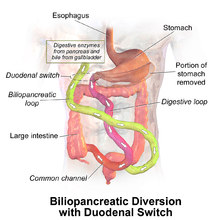
A medical guideline by the American College of Physicians concluded:[4][5]
- "Surgery should be considered as a treatment option for patients with a BMI of 40 kg/m2 or greater who instituted but failed an adequate exercise and diet program (with or without adjunctive drug therapy) and who present with obesity-related comorbid conditions, such as hypertension, impaired glucose tolerance, diabetes mellitus, hyperlipidemia, and obstructive sleep apnea. A doctor–patient discussion of surgical options should include the long-term side effects, such as a possible need for reoperation, gallbladder disease, and malabsorption."
- "Patients should be referred to high-volume centers with surgeons experienced in bariatric surgery."
The surgery is contraindicated in patients who have end stage disease and also in patients not committed to make lifestyle changes considered ideal for the surgery.
In 2011, the International Diabetes Federation issued a position statement suggesting "Under some circumstances, people with a BMI 30–35 should be eligible for surgery."[6] When determining eligibility for bariatric surgery for extremely obese patients, psychiatric screening is critical; it is also critical for determining postoperative success. Patients with a body-mass index of 40 kg/m2 or greater have a 5-fold risk of depression, and half of bariatric surgery candidates are depressed.[7][8]
Weight loss
In general, the malabsorptive procedures lead to more weight loss than the restrictive procedures; however, they have a higher risk profile. A meta-analysis from University of California, Los Angeles, reports the following weight loss at 36 months:[5]
- Biliopancreatic diversion — 117 Lbs / 53 kg
- Roux-en-Y gastric bypass (RYGB) — 90 Lbs / 41 kg
- Open — 95 Lbs/ 43 kg
- Laparoscopic — 84 Lbs / 38 kg
- Vertical banded gastroplasty — 71 Lbs / 32 kg
A 2017 meta-analysis showed bariatric surgery to be effective for weight loss in adolescents, as assessed 36 months after the intervention. The same meta-analysis noted that additional data is needed to determine whether it is also effective for long-term weight loss in adolescents.[9] According to the Canadian Agency for Drugs and Technologies in Health, the comparative evidence base for bariatric surgery in adolescents and young adults is "...limited to a few studies that were narrow in scope and with relatively small sample sizes."[10]
Another 2017 meta-analysis reported that it was effective at reducing weight among morbidly obese adults in China.[11]
Reduced mortality and morbidity
In the short term, weight loss from bariatric surgeries is associated with reductions in some comorbidities of obesity, such as diabetes, metabolic syndrome and sleep apnea, but the benefit for hypertension is uncertain. It is uncertain whether any given bariatric procedure is more effective than another in controlling comorbidities. There is no high quality evidence concerning longer-term effects compared with conventional treatment on comorbidities.[12]
Bariatric surgery in older patients has also been a topic of debate, centered on concerns for safety in this population; the relative benefits and risks in this population is not known.[12]
Given the remarkable rate of diabetes remission with bariatric surgery, there is considerable interest in offering this intervention to people with type 2 diabetes who have a lower BMI than is generally required for bariatric surgery, but high quality evidence is lacking and optimal timing of the procedure is uncertain.[12]
Laparoscopic bariatric surgery requires a hospital stay of only one or two days. Short-term complications from laparoscopic adjustable gastric banding are reported to be lower than laparoscopic Roux-en-Y surgery, and complications from laparoscopic Roux-en-Y surgery are lower than conventional (open) Roux-en-Y surgery.[1][13][14]
Fertility and pregnancy
The position of the American Society for Metabolic and Bariatric Surgery as of 2017 was that it was not clearly understood whether medical weight-loss treatments or bariatric surgery had an effect responsiveness to subsequent treatments for infertility in both men and women.[15] Bariatric surgery reduces the risk of gestational diabetes and hypertensive disorders of pregnancy in women who later become pregnant but increases the risk of preterm birth.[16]
Psychiatric and psychological
Some studies have suggested that psychological health can improve after bariatric surgery.[17]
Adverse effects
Weight loss surgery in adults is associated with relatively large risks and complications, compared to other treatments for obesity.[18]
The likelihood of major complications from weight-loss surgery is 4%.[19] “Sleeve gastrectomy had the lowest complication and reoperation rates of the three (main weight-loss surgery) procedures.....The percentage of procedures requiring reoperations due to complications was 15.3 percent for the gastric band, 7.7 percent for gastric bypass and 1.5 percent for sleeve gastrectomy” - American Society for Metabolic and Bariatric Surgery[20]
As the rate of complications appears to be reduced when the procedure is performed by an experienced surgeon, guidelines recommend that surgery be performed in dedicated or experienced units.[4] It has been observed that the rate of leaks was greater in low volume centres whereas high volume centres showed a lesser leak rate. Leak rates have now globally decreased to a mean of 1-5%.
Metabolic bone disease manifesting as osteopenia and secondary hyperparathyroidism have been reported after Roux-en-Y gastric bypass surgery due to reduced calcium absorption. The highest concentration of calcium transporters is in the duodenum. Since the ingested food will not pass through the duodenum after a bypass procedure, calcium levels in the blood may decrease, causing secondary hyperparathyroidism, increase in bone turnover, and a decrease in bone mass. Increased risk of fracture has also been linked to bariatric surgery.[21]
Rapid weight loss after obesity surgery can contribute to the development of gallstones as well by increasing the lithogenicity of bile. Adverse effects on the kidneys have been studied. Hyperoxaluria that can potentially lead to oxalate nephropathy and irreversible renal failure is the most significant abnormality seen on urine chemistry studies. Rhabdomyolysis leading to acute kidney injury, and impaired renal handling of acid and base has been reported after bypass surgery.[22]
Nutritional derangements due to deficiencies of micronutrients like iron, vitamin B12, fat soluble vitamins, thiamine, and folate are especially common after malabsorptive bariatric procedures. Seizures due to hyperinsulinemic hypoglycemia have been reported. Inappropriate insulin secretion secondary to islet cell hyperplasia, called pancreatic nesidioblastosis, might explain this syndrome.[23][24][25]
Self-harm behaviors and suicide appear to be increased in people with mental health issues in the five years after bariatric surgery had been done.[26]
Types
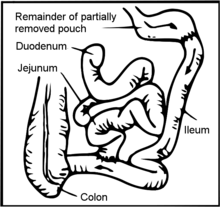
Procedures can be grouped in three main categories: blocking, restricting, and mixed.[27] Standard of care in the United States and most of the industrialized world in 2009 is for laparoscopic as opposed to open procedures. Future trends are attempting to achieve similar or better results via endoscopic procedures.
Blocking procedures
Some procedures block absorption of food, although they also reduce stomach size.
Biliopancreatic diversion
This operation is termed biliopancreatic diversion (BPD) or the Scopinaro procedure. The original form of this procedure is now rarely performed because of problems with. It has been replaced with a modification known as duodenal switch (BPD/DS). Part of the stomach is resected, creating a smaller stomach (however the patient can eat a free diet as there is no restrictive component). The distal part of the small intestine is then connected to the pouch, bypassing the duodenum and jejunum.
In around 2% of patients there is severe malabsorption and nutritional deficiency that requires restoration of the normal absorption. The malabsorptive effect of BPD is so potent that, as in most restrictive procedures, those who undergo the procedure must take vitamin and dietary minerals above and beyond that of the normal population. Without these supplements, there is risk of serious deficiency diseases such as anemia and osteoporosis.
Because gallstones are a common complication of the rapid weight loss following any type of bariatric surgery, some surgeons remove the gallbladder as a preventive measure during BPD. Others prefer to prescribe medications to reduce the risk of post-operative gallstones.
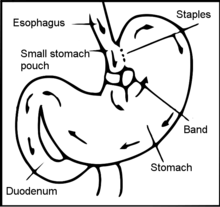
Far fewer surgeons perform BPD compared to other weight loss surgeries, in part because of the need for long-term nutritional follow-up and monitoring of BPD patients.
Jejunoileal bypass
This procedure is no longer performed. It was a surgical weight-loss procedure performed for the relief of morbid obesity from the 1950s through the 1970s in which all but 30 cm (12 in) to 45 cm (18 in) of the small bowel was detached and set to the side.
Endoluminal sleeve
A study on humans was done in Chile using the same technique [28] however the results were not conclusive and the device had issues with migration and slipping. A study recently done in the Netherlands found a decrease of 5.5 BMI points in 3 months with an endoluminal sleeve
Restrictive procedures
Procedures that are restrictive shrink the size of the stomach or take up space inside the stomach, making people feel more full when they eat less.[29]
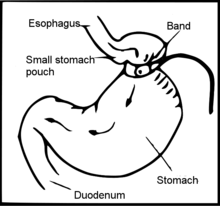
Vertical banded gastroplasty
In the vertical banded gastroplasty, also called the Mason procedure or stomach stapling, a part of the stomach is permanently stapled to create a smaller pre-stomach pouch, which serves as the new stomach.[30]
Adjustable gastric band
The restriction of the stomach also can be created using a silicone band, which can be adjusted by addition or removal of saline through a port placed just under the skin. This operation can be performed laparoscopically, and is commonly referred to as a "lap band". Weight loss is predominantly due to the restriction of nutrient intake that is created by the small gastric pouch and the narrow outlet. [31] It is considered one of the safest procedures performed today with a mortality rate of 0.05%. [32]
Sleeve gastrectomy

Sleeve gastrectomy, or gastric sleeve, is a surgical weight-loss procedure in which the stomach is reduced to about 15% of its original size, by surgical removal of a large portion of the stomach, following the major curve. The open edges are then attached together (typically with surgical staples, sutures, or both) to leave the stomach shaped more like a tube, or a sleeve, with a banana shape. The procedure permanently reduces the size of the stomach. The procedure is performed laparoscopically and is not reversible. It has been found to be comparable in effectiveness to Roux-en-Y gastric bypass.[33]
Intragastric balloon
Intragastric balloon involves placing a deflated balloon into the stomach, and then filling it to decrease the amount of gastric space. The balloon can be left in the stomach for a maximum of 6 months and results in an average weight loss of 5–9 BMI over half a year.[34] The intragastric balloon is approved in Australia, Canada, Mexico, India, United States (received FDA approval in 2015) and several European and South American countries.[35][36] The intragastric balloon may be used prior to another bariatric surgery in order to assist the patient to reach a weight which is suitable for surgery, further it can also be used on several occasions if necessary.[37]
There are three cost categories for the intragastric balloon: pre-operative (e.g. professional fees, lab work and testing), the procedure itself (e.g. surgeon, surgical assistant, anesthesia and hospital fees) and post-operative (e.g. follow-up physician office visits, vitamins and supplements).
Quoted costs for the intragastric balloon are surgeon-specific and vary by region. Average quoted costs by region are as follows (provided in United States Dollars for comparison): Australia: US$4,178; Canada: US$8,250; Mexico: US$5,800; United Kingdom: US$6,195; United States: US$8,150).[38]
Stomach folding
Basically, the procedure can best be understood as a version of the more popular gastric sleeve or gastrectomy surgery where a sleeve is created by suturing rather than removing stomach tissue thus preserving its natural nutrient absorption capabilities. Gastric plication significantly reduces the volume of the patient's stomach, so smaller amounts of food provide a feeling of satiety. The procedure is producing some significant results that were published in a recent study in Bariatric Times and are based on post-operative outcomes for 66 patients (44 female) who had the gastric sleeve plication procedure between January 2007 and March 2010. Mean patient age was 34, with a mean BMI of 35. Follow-up visits for the assessment of safety and weight loss were scheduled at regular intervals in the postoperative period. No major complications were reported among the 66 patients. Weight loss outcomes are comparable to gastric bypass.
The study describes gastric sleeve plication (also referred to as gastric imbrication or laparoscopic greater curvature plication) as a restrictive technique that eliminates the complications associated with adjustable gastric banding and vertical sleeve gastrectomy—it does this by creating restriction without the use of implants and without gastric resection (cutting) and staples.
Mixed procedures
Mixed procedures apply block and restrict at the same time.
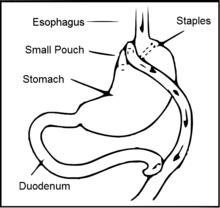
Gastric bypass surgery
A common form of gastric bypass surgery is the Roux-en-Y gastric bypass, designed to reduce the amount of food a person is able to eat by cutting away a part of the stomach. Gastric bypass is a permanent procedure that helps patients by changing how the stomach and small intestine handle the food that is eaten to achieve and maintain weight loss goals.[39] After the surgery, the stomach will be smaller. A patient will feel full with less food.
The gastric bypass had been the most commonly performed operation for weight loss in the United States, and approximately 140,000 gastric bypass procedures were performed in 2005. Its market share has decreased since then and by 2011, the frequency of gastric bypass was thought to be less than 50% of the weight loss surgery market. [29]
A factor in the success of any bariatric surgery is strict post-surgical adherence to a healthy pattern of eating.
There are certain patients who cannot tolerate the malabsorption and dumping syndrome associated with gastric bypass. In such patients, although earlier considered to be an irreversible procedure, there are instances where gastric bypass procedure can be partially reversed.
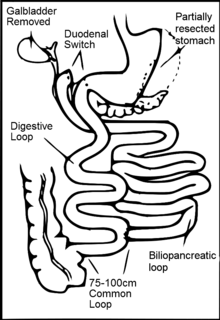
Sleeve gastrectomy with duodenal switch
A variation of the biliopancreatic diversion includes a duodenal switch. The part of the stomach along its greater curve is resected. The stomach is "tubulized" with a residual volume of about 150 ml. This volume reduction provides the food intake restriction component of this operation. This type of gastric resection is anatomically and functionally irreversible. The stomach is then disconnected from the duodenum and connected to the distal part of the small intestine. The duodenum and the upper part of the small intestine are reattached to the rest at about 75–100 cm from the colon.Gastric Sleeve Surgery Steps & Procedure
Implantable gastric stimulation
This procedure where a device similar to a heart pacemaker that is implanted by a surgeon, with the electrical leads stimulating the external surface of the stomach, is being studied in the USA. Electrical stimulation is thought to modify the activity of the enteric nervous system of the stomach, which is interpreted by the brain to give a sense of satiety, or fullness. Early evidence suggests that it is less effective than other forms of bariatric surgery.[40]
Subsequent procedures
After a person successfully loses weight following bariatric surgery, they are usually left with excess skin. These are addressed in a series of plastic surgery procedures sometimes called body contouring in which the skin flaps are removed. Targeted areas include the arms, buttocks and thighs, abdomen, and breasts.[41] These procedures are taken slowly, step by step, and from beginning to end often takes three years.[42] A single body lifting operation can require seven to 10 hours under general anesthesia, blood transfusions and often, another surgeon to assist. Possible risks include infections and reactions and complications due to being under anesthesia for longer than six hours. The person may also experience seroma, a buildup of fluid; dehiscence (wound separation) and deep vein thrombosis (blood clots forming in the legs.) Rare complications include lymphatic injury and major wound dehiscence. The hospital stay for the procedure can require from one to four days while recovery can require about a month.[43]
Eating after bariatric surgery
Immediately after bariatric surgery, the patient is restricted to a clear liquid diet, which includes foods such as clear broth, diluted fruit juices or sugar-free drinks and gelatin desserts. This diet is continued until the gastrointestinal tract has recovered somewhat from the surgery. The next stage provides a blended or pureed sugar-free diet for at least two weeks. This may consist of high protein, liquid or soft foods such as protein shakes, soft meats, and dairy products. Foods high in carbohydrates are usually avoided when possible during the initial weight loss period.
Post-surgery, overeating is curbed because exceeding the capacity of the stomach causes nausea and vomiting. Diet restrictions after recovery from surgery depend in part on the type of surgery. Many patients will need to take a daily multivitamin pill for life to compensate for reduced absorption of essential nutrients.[44] Because patients cannot eat a large quantity of food, physicians typically recommend a diet that is relatively high in protein and low in fats and alcohol.
Fluid recommendations
It is very common, within the first month post-surgery, for a patient to undergo volume depletion and dehydration. Patients have difficulty drinking the appropriate amount of fluids as they adapt to their new gastric volume. Limitations on oral fluid intake, reduced calorie intake, and a higher incidence of vomiting and diarrhea are all factors that have a significant contribution to dehydration.[45]
Youth
As childhood obesity has more than doubled over recent years and more than tripled in adolescents (according to the Centers for Disease Control and Prevention), bariatric surgery for youth has become increasingly common.[46][47] Some worry that a decline in life expectancy might occur from the increasing levels of obesity,[48] so providing youth with proper care may help prevent the serious medical complications caused by obesity and its related diseases. Difficulties and ethical issues arise when making decisions related to obesity treatments for those that are too young or otherwise unable to give consent without adult guidance.[46]
Children and adolescents are still developing, both physically and mentally. This makes it difficult for them to make an informed decision and give consent to move forward with a treatment.[49] These patients may also be experiencing severe depression or other psychological disorders related to their obesity that make understanding the information very difficult.[46][50]
History
Open weight loss surgery began slowly in the 1950s with the intestinal bypass. It involved anastomosis of the upper and lower intestine, which bypasses a large amount of the absorptive circuit, which caused weight loss purely by the malabsorption of food. Later Drs. J. Howard Payne, Lorent T. DeWind and Robert R. Commons developed in 1963 the Jejuno-colic Shunt, which connected the upper small intestine to the colon. The laboratory research leading to gastric bypass did not begin until 1965 when Dr. Edward E. Mason (b. 1920) and Dr. Chikashi Ito (1930–2013) at the University of Iowa developed the original gastric bypass for weight reduction which led to fewer complications than the intestinal bypass and for this reason Mason is known as the "father of obesity surgery".[51]
References
- Robinson MK (July 2009). "Editorial: Surgical treatment of obesity—weighing the facts". The New England Journal of Medicine. 361 (5): 520–1. doi:10.1056/NEJMe0904837. PMID 19641209.
- Fajnwaks P, Ramirez A, Martinez P, Arias E, Szomstein S, Rosenthal R (May 2008). "P46: Outcomes of bariatric surgery in patients with BMI less than 35 kg/m2". Surgery for Obesity and Related Diseases. 4 (3): 329. doi:10.1016/j.soard.2008.03.107.
- Courcoulas AP, Yanovski SZ, Bonds D, Eggerman TL, Horlick M, Staten MA, Arterburn DE (December 2014). "Long-term outcomes of bariatric surgery: a National Institutes of Health symposium". JAMA Surgery. 149 (12): 1323–9. doi:10.1001/jamasurg.2014.2440. PMC 5570469. PMID 25271405.
- Snow V, Barry P, Fitterman N, Qaseem A, Weiss K (April 2005). "Pharmacologic and surgical management of obesity in primary care: a clinical practice guideline from the American College of Physicians". Annals of Internal Medicine. 142 (7): 525–31. doi:10.7326/0003-4819-142-7-200504050-00011. PMID 15809464.
- Maggard MA, Shugarman LR, Suttorp M, Maglione M, Sugerman HJ, Sugarman HJ, Livingston EH, Nguyen NT, Li Z, Mojica WA, Hilton L, Rhodes S, Morton SC, Shekelle PG (April 2005). "Meta-analysis: surgical treatment of obesity". Annals of Internal Medicine. 142 (7): 547–59. doi:10.7326/0003-4819-142-7-200504050-00013. PMID 15809466.
- "International Diabetes Federation position statement on Bariatric Surgical and Procedural Interventions in the Treatment of Obese Patients with Type 2 Diabetes" (PDF). Archived from the original (PDF) on 2011-07-02. Retrieved 2011-08-01.
- Yen YC, Huang CK, Tai CM (September 2014). "Psychiatric aspects of bariatric surgery". Current Opinion in Psychiatry. 27 (5): 374–9. doi:10.1097/YCO.0000000000000085. PMC 4162326. PMID 25036421.
- Lin HY, Huang CK, Tai CM, Lin HY, Kao YH, Tsai CC, Hsuan CF, Lee SL, Chi SC, Yen YC (January 2013). "Psychiatric disorders of patients seeking obesity treatment". BMC Psychiatry. 13: 1. doi:10.1186/1471-244X-13-1. PMC 3543713. PMID 23281653.
- Pedroso FE, Angriman F, Endo A, Dasenbrock H, Storino A, Castillo R, Watkins AA, Castillo-Angeles M, Goodman JE, Zitsman JL (March 2018). "Weight loss after bariatric surgery in obese adolescents: a systematic review and meta-analysis". Surgery for Obesity and Related Diseases. 14 (3): 413–422. doi:10.1016/j.soard.2017.10.003. PMID 29248351.
- "Bariatric Surgery for Adolescents and Young Adults: A Review of Comparative Clinical Effectiveness, Cost-Effectiveness, and Evidence-Based Guidelines". CADTH Rapid Response Reports. Canadian Agency for Drugs and Technologies in Health. 2016. PMID 27831668. Cite journal requires
|journal=(help) - Zeng T, Cai Y, Chen L (October 2017). "The Effectiveness of Bariatric Surgery for Chinese Obesity in 2 Years: A Meta-Analysis and Systematic Review". Journal of Investigative Surgery. 30 (5): 332–341. doi:10.1080/08941939.2016.1249442. PMID 27806209.
- Colquitt JL et al. Surgery for weight loss in adults. Cochrane Database Syst Rev. 2014 Aug 8;8:CD003641. doi: 10.1002/14651858.CD003641.pub4. PMID 25105982
- Flum DR, Belle SH, King WC, Wahed AS, Berk P, Chapman W, Pories W, Courcoulas A, McCloskey C, Mitchell J, Patterson E, Pomp A, Staten MA, Yanovski SZ, Thirlby R, Wolfe B (July 2009). "Perioperative safety in the longitudinal assessment of bariatric surgery". The New England Journal of Medicine. 361 (5): 445–54. doi:10.1056/NEJMoa0901836. PMC 2854565. PMID 19641201.
- Nguyen NT, Silver M, Robinson M, Needleman B, Hartley G, Cooney R, Catalano R, Dostal J, Sama D, Blankenship J, Burg K, Stemmer E, Wilson SE (May 2006). "Result of a national audit of bariatric surgery performed at academic centers: a 2004 University HealthSystem Consortium Benchmarking Project". Archives of Surgery. 141 (5): 445–9, discussion 449–50. doi:10.1001/archsurg.141.5.445. PMID 16702515.
- Kominiarek MA, Jungheim ES, Hoeger KM, Rogers AM, Kahan S, Kim JJ (May 2017). "American Society for Metabolic and Bariatric Surgery position statement on the impact of obesity and obesity treatment on fertility and fertility therapy Endorsed by the American College of Obstetricians and Gynecologists and the Obesity Society". Surgery for Obesity and Related Diseases. 13 (5): 750–757. doi:10.1016/j.soard.2017.02.006. PMID 28416185.
- Kwong W, Tomlinson G, Feig DS (June 2018). "Maternal and neonatal outcomes after bariatric surgery; a systematic review and meta-analysis: do the benefits outweigh the risks?". American Journal of Obstetrics and Gynecology. 218 (6): 573–580. doi:10.1016/j.ajog.2018.02.003. PMID 29454871.
- Kubik JF, Gill RS, Laffin M, Karmali S (2013). "The impact of bariatric surgery on psychological health". Journal of Obesity. 2013: 1–5. doi:10.1155/2013/837989. PMC 3625597. PMID 23606952.
- Beaulac J, Sandre D (May 2017). "Critical review of bariatric surgery, medically supervised diets, and behavioural interventions for weight management in adults". Perspectives in Public Health. 137 (3): 162–172. doi:10.1177/1757913916653425. PMID 27354536.
- Flum DR, Belle SH, King WC, Wahed AS, Berk P, Chapman W, Pories W, Courcoulas A, McCloskey C, Mitchell J, Patterson E, Pomp A, Staten MA, Yanovski SZ, Thirlby R, Wolfe B (July 2009). "Perioperative safety in the longitudinal assessment of bariatric surgery". The New England Journal of Medicine. 361 (5): 445–54. doi:10.1056/nejmoa0901836. PMC 2854565. PMID 19641201.
- "Studies Weigh in on Safety and Effectiveness of Newer Bariatric and Metabolic Surgery Procedure - American Society for Metabolic and Bariatric Surgery". American Society for Metabolic and Bariatric Surgery.
- "Bariatric Surgery Linked to Increased Fracture Risk". Science Daily. Retrieved 2011-06-05.
- "Bariatric Surgery: A Detailed Overview". bariatricguide.org. Bariatric Surgery Information Guide. Retrieved 15 July 2013.
- Chauhan V, Vaid M, Gupta M, Kalanuria A, Parashar A (August 2010). "Metabolic, renal, and nutritional consequences of bariatric surgery: implications for the clinician". Southern Medical Journal. 103 (8): 775–83, quiz 784–5. doi:10.1097/SMJ.0b013e3181e6cc3f. PMID 20622731.
- "Reproductive and Other Health Considerations for Women Undergoing Bariatric Surgery". Journal Watch.
- Miller K (2008). Comparison of Nutritional Deficiencies and Complications following Vertical Sleeve Gastrectomy, Roux-en-y Gastric Bypass, and Biliopancreatic Diversion with Duodenal Switch (Ph.D. thesis). Bowling Green State University. Retrieved 15 June 2018.
- Bhatti JA, Nathens AB, Thiruchelvam D, Grantcharov T, Goldstein BI, Redelmeier DA (March 2016). "Self-harm Emergencies After Bariatric Surgery: A Population-Based Cohort Study". JAMA Surgery. 151 (3): 226–32. doi:10.1001/jamasurg.2015.3414. PMID 26444444.
- Abell TL, Minocha A (April 2006). "Gastrointestinal complications of bariatric surgery: diagnosis and therapy". The American Journal of the Medical Sciences. 331 (4): 214–8. doi:10.1097/00000441-200604000-00008. PMID 16617237.
- "Intestinal Sleeve May Improve Glycemic Control". medpagetoday.com. 16 November 2009.
- Stanczyk M, Martindale RG, Deveney C (2007). "53 Bariatric Surgery Overview". In Berdanier CD, Feldman EB, Dwyer J (eds.). Handbook of Nutrition and Food. Boca Raton, FL: CRC Press. pp. 915–926.
- "Revisional Weight Loss Surgery". bmisurgery.com. 30 September 2015. Archived from the original on 20 February 2018. Retrieved 19 February 2018.
- Shikora SA, Kim JJ & Tarnoff ME (February 2007). "Nutrition and gastrointestinal complications of bariatric surgery". Nutrition in Clinical Practice. 22 (1): 29–40. doi:10.1177/011542650702200129. PMID 17242452.
- Freitas A, Sweeney JF (2010). "20. Bariatric Surgery". In B. Banerjee (ed.). Nutritional Management of Digestive Disorders. Boca Raton, FL: CRC Press. pp. 327–342.
- Kang JH, Le QA (November 2017). "Effectiveness of bariatric surgical procedures: A systematic review and network meta-analysis of randomized controlled trials". Medicine. 96 (46): e8632. doi:10.1097/MD.0000000000008632. PMC 5704829. PMID 29145284.
- Mathus-Vliegen EM (2008). "Intragastric balloon treatment for obesity: what does it really offer?". Digestive Diseases. 26 (1): 40–4. doi:10.1159/000109385. PMID 18600014.
- Rosenthal E (January 3, 2006). "Europeans Find Extra Options for Staying Slim". The New York Times. Retrieved April 26, 2010.
- "FDA approves non-surgical temporary balloon device to treat obesity". U.S. Food and Drug Administration. July 30, 2015. Retrieved September 22, 2015.
- "Archived copy". Archived from the original on 2010-12-01. Retrieved 2010-12-12.CS1 maint: archived copy as title (link)
- Gastric Balloon Surgery: Complete Patient Guide (Annual Gastric Balloon Cost Survey), Bariatric Surgery Source, retrieved 22 September 2015
- "Roux-en-Y Gastric Bypass Surgery Risks, Complications & Benefits". Retrieved 19 September 2016.
- Pardo JV, Sheikh SA, Kuskowski MA, Surerus-Johnson C, Hagen MC, Lee JT, Rittberg BR, Adson DE (November 2007). "Weight loss during chronic, cervical vagus nerve stimulation in depressed patients with obesity: an observation". International Journal of Obesity. 31 (11): 1756–9. doi:10.1038/sj.ijo.0803666. PMC 2365729. PMID 17563762.
- Chandawarkar RY (2006). "Body contouring following massive weight loss resulting from bariatric surgery". Advances in Psychosomatic Medicine. 27: 61–72. doi:10.1159/000090964. ISBN 3-8055-8028-2. PMID 16418543.
- Chandawarkar RY (2006). "Body contouring following massive weight loss resulting from bariatric surgery". Advances in Psychosomatic Medicine. 27: 61–72. doi:10.1159/000090964. ISBN 3-8055-8028-2. PMID 16418543.
- Borud LJ, Warren AG (July 2006). "Body contouring in the postbariatric surgery patient". Journal of the American College of Surgeons. 203 (1): 82–93. doi:10.1016/j.jamcollsurg.2006.01.015. PMID 16798490.
- Tucker ON, Szomstein S, Rosenthal RJ (May 2007). "Nutritional consequences of weight-loss surgery". The Medical Clinics of North America. 91 (3): 499–514, xii. doi:10.1016/j.mcna.2007.01.006. PMID 17509392.
- Petering R & Webb CW (2009). "Exercise, fluid, and nutrition recommendations for the postgastric bypass exerciser". Current Sports Medicine Reports. 8 (2): 92–7. doi:10.1249/JSR.0b013e31819e2cd6. PMID 19276910.
- Hofmann B (April 2013). "Bariatric surgery for obese children and adolescents: a review of the moral challenges". BMC Medical Ethics. 14 (1): 18. doi:10.1186/1472-6939-14-18. PMC 3655839. PMID 23631445.
- "Childhood Obesity Facts". Centers for Disease Control and Prevention. Archived from the original on 17 March 2018. Retrieved 19 November 2013.
- Caniano DA (August 2009). "Ethical issues in pediatric bariatric surgery". Seminars in Pediatric Surgery. 18 (3): 186–92. doi:10.1053/j.sempedsurg.2009.04.009. PMID 19573761.
- Ells LJ, Mead E, Atkinson G, Corpeleijn E, Roberts K, Viner R, Baur L, Metzendorf MI, Richter B (June 2015). "Surgery for the treatment of obesity in children and adolescents" (PDF). The Cochrane Database of Systematic Reviews (6): CD011740. doi:10.1002/14651858.CD011740. PMID 26104326.
- Zeller MH, Roehrig HR, Modi AC, Daniels SR, Inge TH (April 2006). "Health-related quality of life and depressive symptoms in adolescents with extreme obesity presenting for bariatric surgery". Pediatrics. 117 (4): 1155–61. doi:10.1542/peds.2005-1141. PMID 16585310.
- "Alumni Interview: Edward Mason, M.D". Medicine Alumni Society, University of Iowa. Archived from the original on 2014-08-10. Retrieved 2014-08-09.
External links
